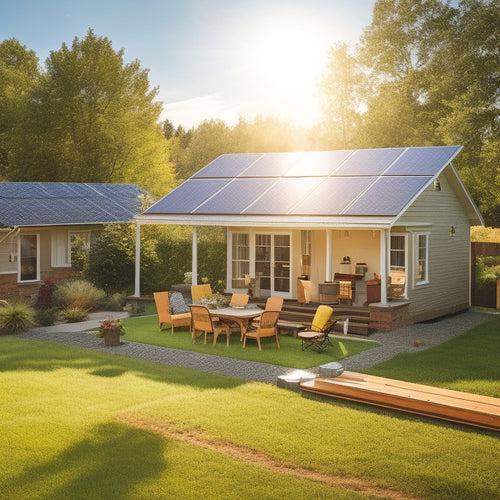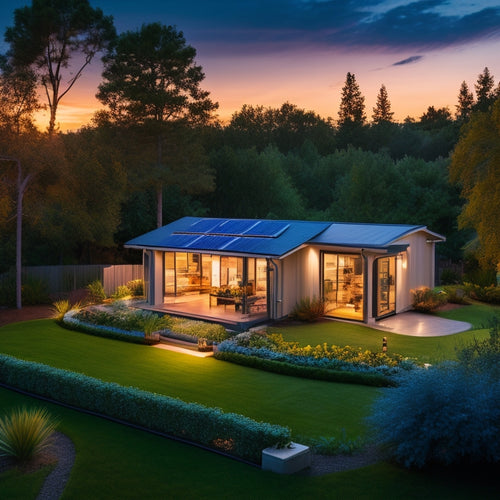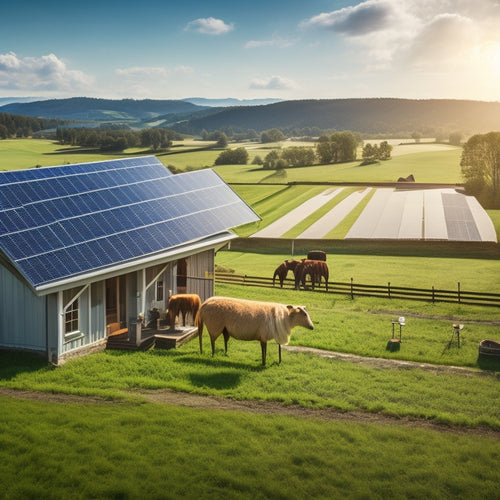
Solar Panels Vs Traditional Energy
Share
You're considering ditching traditional energy sources for solar panels, and rightly so, as traditional energy's staggering environmental impact and rising costs make solar panels an increasingly attractive alternative. Traditional energy sources contribute greatly to carbon footprint and climate change, whereas solar panels produce no emissions during operation. Solar panels also provide energy at a lower cost, averaging 3-6 cents per kilowatt-hour, and serve as a hedge against inflation with fixed energy rates for 25+ years. As you weigh your options, you'll uncover the numerous benefits of solar panels, including energy independence and technological advancements, which will help you make an informed decision about your energy future.
Key Takeaways
- Solar panels reduce carbon footprint and climate change impact, unlike traditional energy sources that contribute significantly to these issues.
- Solar energy costs 3-6 cents per kWh, compared to 12 cents per kWh for traditional energy, resulting in long-term savings.
- Solar panels provide control over electricity costs and usage, offering energy independence and security against price volatility.
- While traditional energy sources deplete resources and disrupt ecosystems, solar panels produce no emissions during operation, making them a cleaner option.
- Solar panels require minimal maintenance, with infrequent cleaning and scheduled inspections, reducing upkeep costs and increasing efficiency.
Environmental Impact Assessment
As the global quest for sustainable energy solutions intensifies, the environmental impact of our energy choices takes center stage.
You're likely aware that traditional energy sources, such as fossil fuels, have significant drawbacks. For instance, they contribute heavily to your carbon footprint, which exacerbates climate change. The extraction and processing of these resources also lead to resource depletion, disrupting ecosystems and wildlife habitats.
Furthermore, the land required for traditional energy production can result in habitat destruction and fragmentation, further threatening biodiversity.
In contrast, solar panels offer a cleaner alternative. While they do require land for installation, the overall land use is relatively minimal. Additionally, solar panels produce no emissions during operation, reducing your carbon footprint.
However, you should consider the manufacturing emissions associated with solar panel production, as well as the recycling challenges that arise at the end of their life cycle. Despite these limitations, solar panels present a more environmentally friendly option, making them an attractive choice for those seeking to minimize their ecological impact.
Energy Cost Comparison
You've weighed the environmental implications of solar panels versus traditional energy sources, and now it's time to examine the cost factor.
When considering energy costs, it's crucial to assess the long-term benefits of solar panels. With solar panels, you can reduce your reliance on the grid and enjoy significant solar savings.
On average, traditional energy sources cost around 12 cents per kilowatt-hour (kWh). In contrast, solar panels can provide energy at a rate of 3-6 cents per kWh, depending on the location and system size. Over time, these savings can add up, resulting in substantial reductions to your energy bills.
Moreover, as traditional energy costs continue to rise, solar panels offer a hedge against inflation. By investing in solar panels, you can lock in a fixed energy rate for the next 25 years or more, providing a sense of security and predictability.
Installation and Maintenance Needs
The upfront cost of installing solar panels can be significant, but it's essential to evaluate the long-term benefits and minimal maintenance needs.
You'll need to take into account site preparation, including evaluating your roof's condition and confirming it's structurally sound. System sizing is also fundamental, as it determines the number of panels required to meet your energy needs.
When it comes to installation, you can expect a professional team to handle the process, which typically takes a few days to a few weeks, depending on the complexity of the project.
Once installed, maintenance is minimal, and you can expect:
- Infrequent cleaning to guarantee ideal energy production
- Scheduled inspections to identify potential issues
- Replacement of inverters every 10-15 years
- Monitoring system performance to guarantee ideal energy production
- Occasional pruning of nearby trees to maintain ideal sunlight exposure
Energy Independence Benefits
Switching to solar energy allows you to break free from reliance on traditional energy sources, giving you control over your electricity costs and usage.
This shift towards energy independence provides you with a sense of security, as you're no longer at the mercy of fluctuating fuel prices or supply chain disruptions.
With solar panels, you're generating your own clean energy, reducing your reliance on the grid and minimizing your exposure to price volatility.
Technological Advancements Today
As solar energy becomes an increasingly viable alternative to traditional energy sources, advancements in technology are playing a vital role in driving its adoption.
You're likely aware that the efficiency of solar panels has increased markedly over the years, making them a more viable option for power generation. This is largely due to improvements in photovoltaic (PV) cells, which convert sunlight into electricity.
Some key technological advancements include:
-
Bifacial solar panels: capable of utilizing energy from both sides of the panel, increasing solar efficiency by up to 25%.
-
Thin-film solar cells: cheaper and more flexible than traditional PV cells, making them ideal for large-scale installations.
-
Perovskite solar cells: boasting higher power conversion efficiency rates than traditional silicon-based cells.
-
Advanced inverters: enabling more efficient energy conversion and grid integration.
-
Smart battery storage systems: optimizing energy storage and release, ensuring a reliable power supply.
These advancements have made solar energy a more reliable, efficient, and cost-effective option, further bridging the gap with traditional energy sources.
Future of Renewable Energy
Driven by innovation and policy support, the renewable energy environment is ready to experience significant changes in the coming years.
You're likely to see a significant shift in the global energy arena as countries work hard to meet their climate goals and reduce carbon emissions. Governments are implementing policy incentives to encourage investment in renewable energy, driving down costs and increasing adoption rates.
As public awareness about climate change grows, you'll see increased demand for clean energy solutions. This will lead to further innovation in solar panel technology, energy storage, and grid management.
The future of renewable energy is decentralized, with a focus on community-based energy generation and distribution. You'll have more control over your energy usage, with the ability to generate, store, and share energy with your community.
The future is bright for renewable energy, and you're at the forefront of this shift. As the cost of renewable energy continues to decline, you'll see traditional energy sources become less competitive.
Get ready to tap into the power of the sun and take control of your energy future.
Frequently Asked Questions
Can Solar Panels Work During Power Outages?
You can't rely on solar panels to work during power outages unless you have energy storage, like batteries, and a grid-independent system, which allows you to store excess energy generated during the day for use during outages.
How Do Solar Panels Perform in Extreme Weather?
Ha! You think a little rain or shine will stop your solar panels? Think again! In reality, you'll see a slight dip in solar efficiency during extreme weather, but modern panels are built for weather resilience, ensuring consistent power generation despite Mother Nature's tantrums.
Are Solar Panels Compatible With All Roof Types?
When you're considering solar panels, you'll need to verify they're compatible with your roof type. You'll want to check the roof material's compatibility, as well as installation angle considerations, to guarantee a secure and efficient energy harvest.
Can I Install Solar Panels Myself?
You consider installing solar panels yourself, like John, who saved $2,000 on labor costs by doing it himself. However, you'll still need to obtain solar panel permits, and DIY installation requires extensive electrical knowledge, making it a challenging task.
Do Solar Panels Void My Roof Warranty?
When you install solar panels, you're likely wondering if they'll void your roof warranty. The answer depends on the installer and roof type; a reputable installer will guarantee a watertight seal, minimizing roof warranty implications, while a poorly done installation can negatively impact your warranty.
Conclusion
You've weighed the pros and cons of solar panels vs traditional energy. Now, it's time to take the leap. One concern might be, "But solar panels are intermittent, what about when the sun doesn't shine?" However, advancements in energy storage and grid management have mitigated this issue. In reality, solar energy is a reliable, clean, and cost-effective alternative. Embracing solar power not only reduces your carbon footprint but also future-proofs your energy needs. So, make the switch and join the renewable energy revolution.
Related Posts
-

Steps to Prepare for Solar Installation
To prepare for solar installation, start by evaluating your current energy consumption and future needs to determine ...
-

Solar Power Backup Solutions During Outages
Solar power backup solutions guarantee you have reliable energy during outages, providing essential power when the gr...
-

Solar Power Systems for Rural Properties
Solar power systems offer a reliable and efficient energy solution for rural properties, allowing you to gain energy ...


